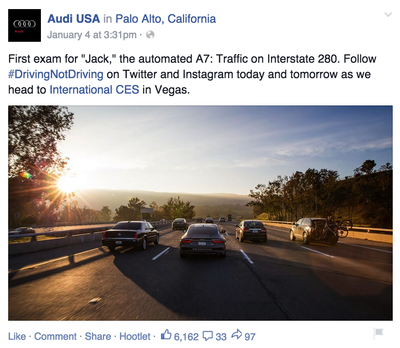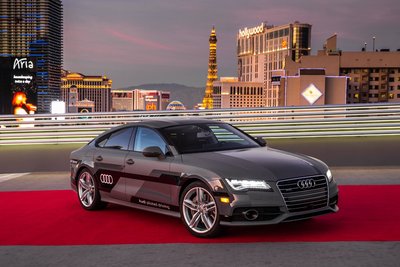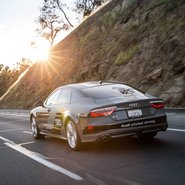German automaker Audi showed that its Audi A7 autonomous concept vehicle can seamlessly meld into traffic by going on a 560-mile test drive.
Audi piloted its concept vehicle, nicknamed “Jack,” from Silicon Valley, CA to Las Vegas for the annual Consumer Electronics Show, which concludes on Jan. 9. In a time when many automakers are unveiling and testing autonomous driving experiences, showing the realistic implications can help consumers learn to trust the latest technologies.
"At this moment, I'm not entirely sure the public wants a self-driving car or even realizes the threat it poses to them," said Rob Frankel, branding expert at marketing consultancy firm Frankel & Anderson, Los Angeles.
"On the one hand, there's the novelty associated with every piece of technology (all I want is a watch that tells me the time, not who's posted on Facebook)," he said. "On the other, there's the increasing influence of technology designed to decrease the individual's accountability, to the point of making everyone
dependent on technology -- and paying for the privilege.
"Not to mention the serious economic impact of self-driving vehicles: they drain even more jobs of professional truck and cab drivers."
Mr. Frankel is not affiliated with Audi, but agreed to comment as an industry expert.
Audi did not respond by press deadline.
Look ma, no hands
Audi encouraged its fans to follow Jack’s 560-mile test drive on Instagram and Twitter. Photos and short videos posted to Instagram, for example, show the vehicle's interior and exterior as well as guest journalists experiencing autonomous driving in the Audi A7.
The automaker used the hashtag #DrivingNotDriving during the duration of the test drive.

Audi's Facebook post for the Audi A7 #DrivingNotDriving test drive
From the passenger seat of the Audi A7, experienced Audi test drivers accompanied the journalists on 100 mile stints in various traffic conditions on public roadways. This occasion marks the longest autonomous test drive conducted by the general public since the technology has been introduced.
By undertaking a drive, 560 miles over two days, that shows average drivers behind the wheel will likely instill a sense of trust among other consumers who may feel that autonomous driving is still too much of a futuristic concept.
Audi’s concept vehicle uses various production-ready sensors, similar to those already in use, on a larger scale to accurately detect the automobile’s surroundings. These sensors include adaptive cruise control, Audi side assist long-range radar and mid-range radar sensors at the vehicle's front and back end, angled to the left and right, to give a 360-degree view.
Also, laser scanners are fitted to the Singleframe grille as well as the rear bumper for additional coverage. Four small cameras at the front and rear of the Audi A7 also work to detect “short-range information” of the surroundings while a hi-resolution, wide-angle 3D video camera observes traffic patterns while driving.

Audi A7 in Las Vegas for CES Jan. 6-9
Although it may seem like a redundant amount of data generated by the sensors, lasers and cameras, Audi equates this to “a continuous plausibility check during piloted driving to ensure the correct decisions are being made by the vehicle and driver.”
The Audi A7 can relieve drivers of wheel duties from 0 to 70 mph and can undertake land changes and passing as well as acceleration and braking, independently from the driver. To change lanes, for instance, the Audi A7 will adapt the speed of vehicles nearby and will then calculate a safe speed and distance to navigate into another lane.
Currently, Audi A7’s autonomous driving function is unfit for city roadways. To account for the transition from highway to city roads, the Audi A7 is outfitted with warning signals, such as colored LEDs at the windshield's base, a display in the Central Status Indicator and an acoustic warning, to notify the driver that he must now take control of the wheel.
Strength in numbers
Audi was not the only automaker to make waves at CES by presenting attendees, and those following via social media, with an autonomous driving experience.
German automaker Mercedes-Benz opened the doors on self-driving automobiles with its F 015 “Luxury in Motion” research vehicle released at the Consumer Electronics Show in Las Vegas.
The new vehicle demonstrates the future of driving with its inward facing seats and self-propelled and self-reliant technology that will be able to fully operate a car without human assistance. The release of Mercedes-Benz’s research vehicle will spark interest and gain attention among those who were previously skeptic about self-piloted vehicles and will likely place Mercedes as a leader in autonomous driving technology (see story).
Outside of the trade show circuit, automakers have been working to make autonomous driving more accessible to consumers in the near future.
For example, German automaker BMW brought its technological research in highly automated driving to urban Chinese locations to help reduce traffic accidents in the country’s overpopulated cities.
Over the past year and a half, BMW has been working on a project to bring highly automated driving to German and other European roads. The spread to China will help create a worldwide audience for the technology and will allow highly automated driving to evolve further with the high-levels of traffic in Chinese cities (see story).
With recent advancements, brands are going to have to out do one another to show that their piloted vehicles and technologies are leaders rather than followers.
"Assuming the market really wants the technology -- and that's still a big assumption in my book -- I don't know that it's possible to saturate this kind of market. Like all products and services, technology can be served up in a myriad of ways," Mr. Anderson said.
"Each brand delivers its own style of driverless tech, in much the way Apple and Microsoft serve up their own operating systems, each of which delivers very similar benefits," she said.
Final Take
Jen King, lead reporter on Luxury Daily, New York
{"ct":"sB8w+tNH4e4c3T\/pMkkhPOIpCbChvXkNiqHyJBVCVNVNLTL7eoAMpV5ik8vg8nWfeVlTtKlr8lx9\/fYagcE11rAExdZ2PbehxBLhq3W0JSCEtoE8oBQr0c6wRzeA6BClxzXyfMul8AZ1Q9gNoVYtvLbigsH8VgnOgQl3zWLe1TcRLWN6r4n+gMgU\/ufRFL3ie6MWfgWjuRPNNCZogr0C2InUnl6m3wYGWo1HB0dBdULddaXV6f5bXQ+\/eo9XgSDa\/+ujQlI8xxM97Lc5vdoRmXBofAx4gH572L9AcDte7EnBZ82OfWpcARutacCrk5uv\/k9nGxadgOqFt0AXfBi0U+Q0z2uwjMfRgVbOQqCct7qL71hoYLhKzhYiBRXCTEiTHJUQqiyYnMHapKpp+MmYqAIBQpVpUL0Nj1zCVPpuB6VSmhv\/HAPADETe4UQdCSO\/mCVPnyl35MJ0AcRsCoDCcWFgeCsYXLyIeKtT77lWi4vLNei6euVtUyG1iUqwJuKvUJZhz5O7zklAXn265UiCDxMX5N3oq0S0zGCTAQyBL3nAh72hf6tA6RP\/vApr3VOU5orfRcAIKoYKumFVS7ak0qFsMCE9Z8bH7PuJ55kwwQZZrtOE6h4NnMa4U2C6W9S+eZ6xlZkbelvrEfIfaoW0in7OXY8l34QPm++zF2O3TTbPPBH5voT24gIOk95kmAwmzzTQJckn6Pgy0RH7GNEyQkGqkw4HpQkp9F8\/d91\/c+4l4OuOQrz7bGzMYSZs0ssVn8ZuYUlx5K4ztS404iGB2kaHXTEwJXQK5AHm88jln9jH4HLrWXhCJL3Y4Yq+cFiQag5DQ0V3u2x\/lQCZCcZYwJ5LA0wI1P\/r8LVdJgIyAzuUz3fGMUC6qxbxn9WiztXOg1Fx+KOTS2NTDbf4FqDSV7SL5KQr9T9x9pN7mgN7nKswKYTcZ1NsdSDYMqib42hJQB2BkfWAEh6xdpMEGwGydSX3OQ1hBtItsGNviVoPyDSr8Vu6wFJpmh1ynzyYZjEBuTpVxCoChkE7qCINlVxRFYofs6Ne+8yEe4Vl7fXmegYgj3Iwl+ttIFTkWmVz42cVaM1S1lv1lqsQ\/JB+agubaN2\/9A82gr\/qb7amw1MvGtsdVYVbK1dAU6VhRA77\/84ubYQuUqLeogEkYCydmJAH0NtdNUDfKK11PDgbBANCL85GOXNNZN+Q9+f4brwRf3exqGSQAc0G4nNcQ2M9topvTbMcMcVKA0otUBjNM3dXebjCLBQ2FGPs6he+wu3fcl8smOiXhRlT7O5DdqfMyn4ZjMUBN8\/VgZKVLPKwC6gHqc7ZrHIXFwHrNXRglHfYVs9pCQij3jTgX8iYTHP4sjrzKH\/GF3FaGEVnEbaqcwQS+RKjJdaOd49KiJybaHUBwy\/oPIVfDaaLbZiaj69capx\/TA3FIwOA+grbbpjZc2Rg8SozgI4PgI0JJR7IhrMztb4bSnPB5EkkezQpF\/GtGTS7bYmMDDF19wpdLI4529zOO+8yefeoQVjfQOEo7wwFeUkqbD1QU1\/E6gYSHeCQG7sfzNeGdyo6ctYjRqWjD+aDHv5EBpwBQKf6\/XnjNhk5ROVq50Aro+CbXnuAb25Y+rVHX0Q5SBkBG2o3PocIO5CM3X8ceYJxvHh3ol3j1roJ10JNvRLYZwSlwnEMMJHK7lz8UjQg\/Fsqax6OMgGLvU41MPgKxJoHo3v9p9ZnGPzSfLk0cfn4eP\/1FeTqP4fHFYPUyybx51vahKxY3wxBTfRWzAaPD4ijYjDV04eduqAbId66OHZqpAdHpmWaakrM3vVJTIhIVriHv1vDecUTLWcFUK14jiMRR\/q1qwLNpprI+iTV8LCYMQR9cJo0+uyM9\/Ra3gHHQj35V1krEi7wsMrUn2uchVy9efmZ15P+2Tckg+Hm0uJoo5YGqilYksEXi9FAfI8YkCJSX2kPcjVt73lDNQN9a0WS0yoYPIIYJgaE7wgoRAVdQr15S1liVl0o0SJB2V9J1GWv7GAPpqnEtjzBraQLt+Yudjy37i6S1ZqJ57iFPjTaYWLD4lebn2TaQuCXeJbFsZweqopcxZNc1+LuIJ1YrJdvYregnwuuwtZxHYU++Ey3DEqN8NwxIeqxE8cTSuXEPsvMN5IsprD6ZSPfHALxzEI8wo7eX\/BcwVeLZ0dxKQ2VPd1Ld4t\/napqdG\/VllwlzJdWSil+Zbi8FEupy9+A39Iy\/RheqOfFrfzQUYRkr+n+sKQUXEPXx0ISA4\/sALKY5aesy3YgoVMsQolwBUsiP9MRb6Ly3vNZCo0MiSFwCHyAYMBLxp9q5nCWKFNEd8PPTd7jCnscwYNBHg3\/maWo8scoMAvoeZRu\/LT789CxRRxGcHhkkX3Q5\/yJqB9TVQe+cAXxcSEQy0HSJR4qdrfrY55zPeb3zWFEs5ah3ZslQQ6FchZyVVbcb4NU1sZ80mIi9VasyzG4pU6+\/0JJPHzQAyjGGZDIs6KyIPn1NVGMNJkSBKe8QKiN9yHKJBNJihYnck9DMJRhBmZDiDoKKkOzlnIBtvL8FVizmhfATR76x8LtrQrREYfSGwD60Y3CEoW0VE+GA1XSJkJbSGXkAVBzHvUHXi7h0DshMoG06P\/zCxIsXragVFtqGxxby4WDtBbX6qGzE8gfXTKIrjg+\/k6YP50OudIBJ4sDJv1u4JqE42BBE2egMfqfhb+MHPxDjU+pUCmEjb4utje89076EHywiPrRCXfJjlP4YQUz7PAtQ+FcoVAVWFnHLaqTrO\/YLDxzHev2Uhv8oq7Qr53RRUN10EjhdqlzX1syrv\/mQgbE+BM4lXauKGf\/zY8VWoeTZ9NjJoEXqGjEYsUkNSoaK7ja0w4WfoZm6+Z3yxImQa9kdCG30zKp7CiED78bLPRtWFTKSFZzyvT6jygopU1SVpVvTSraRDH1I\/Z0tRlYQEX8oLJzLbz7zic5zKq7hzmtJ1DI3QFB7D7B68MRhVAXi3lA0CbmtNf6bOLHuoLuKBqFHUk62bjGyaCp4997RgnwmUDAGfqKB8tlB90Wu+KVmqDSrZzY80TnvDnSSH\/9EbAnmle8tCzHFLOJ8ksZ\/S1jXsaXNrH5aT7Syi\/apgUn+jE77JvDhgu2dbEh8MfeE0FIwdl1BXTAxJL4YUBuxMd6NRAYw05ktbuqhV0VpQwomf7p2v36tkRi\/lBhIutnqaW7QmpQO+UHkx4gSWjOIBydl\/egMyfaw2daWBfwkq+OadZa9BTp8AH8VMKJTkwyxwgbFrP5rFlO5t2wRf6b7A+sDHrZ5qStCVBefJADkkOMc06lMKdRQI7ebKspY7WCwkJF4zk21yx8uXPpWv8I7TyqLGywqZlUGm\/jY3tXpkzcMn4BD0Dk8eCFSsyLAvRGNXTD4y9gnLyCGrZJ6u1OJO5m4k1dJ0szushOHVD2jxKnz0zpZV5cQXksMndqJvXZQmeD5WWUb8II3om\/H6bl5TCAfJGDQiema+iMyroXeU3pN4yx4XQuGt5Lf\/wQ4MusHUOulHt4OYhDF0bf0iai7ife0wDbn2o+\/e\/mWZJnEJH2www9UJdg5\/yf6Oe1OWyDZlaOWijz4RHmQjgNTXmf68gN+hQ8qP8CD\/fFCaP2aTRB4+7HfzqdXK5MWppoAB\/r0GmZxi0epD9D1Dy3DTkKboeNCbm1q7Mkx3iyXTzeNqetWyXTeG03WiId8422xsHj5VcdC4RntVRRbi1luJ5Zpk3LSUPR4vfV3\/GdJaTOH11tKNlo+kN3RSYUu6yEEb\/3ryGZ9ppz5bdndhSU46pTNtigpfNXPzH7\/Bqmep0BrAN65GsNk5mDZUVf+OUgBmTpjVTU1i3uhMPrMGBHqv1ENzxrAJUtRkofZwLSRUkHAV04U6LQdF4UdgCuIrqvT2SdlOqJKu7Ng4119Q9XQnx33ioXbRsSoYyeW+rns1duuJ8wpnxTZGqK9TKm+fEcZ8syqN3xUclY4kOIhTxtXvR4qRYzfwdNWZl2qPLX4fpmR6yHXawYcqh6UikjjTqxzDWLRjCSdCqYKjknPjugGZVQQ0ahunMJDTGmzlQLoup3GKyoBvAPVJgGoIOXYE95Kq\/gja8+3yEwGqlPGNsd2+fM7B0EipBj6Ymh\/Pc1HIqBRI0pKaHgc3Eu9oaIKh2jme7m8o7JATT0ciMfMcDHpyb0BdvwdyEXmMuBUp\/de7M\/3Ln7QrPtUGsC2YVmDwupI9P5D+ljZw5Au0E1wgUsJOoFJiJGdIA\/v3JCtYH64zQocnvd6peVakzqFKX6tXdDIA9vRVkJjHFFIbRl4QGckN5BKhq8qQNvBxwRTVQqqII2cI6p3pnqHHhnpgcSdl7+xYaJTFLIU\/V6Zqrys47OtyoTTgrr\/EMm8\/K5CJBkI\/FJu8FzwPLLfVZ+UTLi3VBtwFkJdkhXWX\/agC5v34O+gthmL8\/1+rjHEUm5da4h5coMPKoz8b9hUNXjWMskW3qPB34q5UKfhC7BNXxhwmzqe5gcZ6gEh1ruqg7Al1EuCyi0NP5G+IM5uV1s8E0fYesENGUO60+7e7Ml+G7jEXEomGFwcZEiHypSltmYtDGLGF6vnUdtr3Vt1W+v28b0inQmm2kPPvgkQEzIES7McovYtJkAZXox0J3Iy1eR20oYorlkGqYRgcalKNO70RnwPX82cFyuY5\/ld7o7s4MPkLuThdAz3lC6EzYTLzSo7dTg8Q+GR4nkBFb6Os8DmuVvX1DBuqbjb7c43eNhzdAa12sLeI+T9hBD2Ze6f8aCQmlO8aZf+YqgublO4ai\/jRz+JvlJmmGdEaDiRZvrjkPshhTxCQI+ipbazEIK9YHDwYSxKsnhk0ftAPoHr0q7Uvgt5ptPxsQw8aCrh+T3h8UJowTkIsSOTcOKL+9aiQqp6UbStBfqNWPUa2R7y1fR0dxqHN6JlUxzk2LRiKsdKsNJFfTTBeJlqJ1jB52BOxW3D+WIySsR2dMX1sEcYn6BYzFZaJ6UWSQ7EuypKj\/mofiOElsqUR8GizfM0\/PREvRE343Yg7lar6juc2+StN6V16pFYp+PjkB+y3ef3\/2iZ8inaAtesae6lN7Q5qqx92WhqP+Pzh\/nFm5AsmlnENdR2oCcLWTcC0jVyP3cllE3nPYDidiUSLuV39z0YwzsAEWiiCGniRt8x18yR0yn77BnhQkeXn4jhhW3iKI6ixR++xnnFapYqvuQNcFozHE4TU7NEIqOh45VahIx2LnD9cnsGrXhAvT5VQ6V6g1f9ZaMeAqUQNkGPo0emjZgP2RwzM93V\/aVKDP1E33f6t49oxXYarS7p90CL0AwS5WCX6pVkhKLy5ghNGXb\/HeqW\/BlPGJFI\/gMEuxX9mygIwh\/A\/nEdZUEM2Un\/GwY0ft9manGr4Hu3bahmggXo\/LHc6WZ7N+BN2smTWMCd+P7rrArFXFHx2L\/uiBNaRhPxm\/e2yxH5rnQFJiRD8xELZdsyDh0gksvSr+P\/NocLu2w1Qx2Uxs8Ve7UV07LY4SUOPMf95E0s6wSgnu2EOg1OTmHSJ0Nng2BQTWYsnyscZ3OT7BKiPB7jSbDLnmW7Fgoz4ZgpspaP3VONjsf1SgNsCffsQydoAZcPF4iUY1ygUtW3wiuqOpKaE8U8B7GihTUc543utmOc7NMVgGQ5S3TpA0toTC9Zoo7q1xzX8ExqB2xP\/HJjqNre+zDOhtyRVpxtWY2f1tKkBUJ3MFJa86iVvFTJ1DGT44vftz5nYWtQ29gXWNBru016E5zx6ML0I7alfBz44XaIjRFgIhHQ5dhZmANQh3wt\/Fl46dK3mFrkH+oqiluGsHFikRztCP6mwhZaR5U00SWgpfTamlXx5l++epsKnR1vfk+A+sg9n3NjYPe3uMI7nhk5kYxw0Vvy07rho4zoJW9nrs3kf5uKCZGEZ28MLD4SsFawFYb8O3+QEWEGJt4xfTfzPbvvKgRhDucrMdRxBWhDY9QrH1EUFVDP2EKqxp89UY4JnnLPyYhoZztOMNVbFPlyxfE8Yql2VrvXwfGrU7Yv8pb3utO9PveECYVzdXWK4oFvRXEpWipJlICvGpH8UJNtqEUnA3hHI1vh3PgckvaWysy6X1rgLxEsad0xVz9mDXWeXRDct4Ea29tRZSz59kJ6suSBq\/1bYMtCuaJ+ANrFcFtPtBVUQPFTi3Lvwoq8Txxhr68v2NEmoeOgZPtGP6yxOUvciFukur6uT2JLjABac7ZOkXzu\/eNOR0oYR5d7z1l90kE4q0zWkG9\/RRlksKXy6tdF2\/4\/oJAB02\/iykvzhkqgRTGXeL5OXPrbmvy8o7x+HOuFNeEDoaqH8TbWnPmabFHUnlsX3BkvH6XeKwShD3z3v9gJyMNVeVCWBJxmN+NuLhm3od506o+wlcgKxsfCBUj4sHKWuqk99TP4B18ZUZ0JqO3iCi2elYpwmDAG9j2Hw+wAqNIzI8PJiMJMY\/YZY6ukufuwx9CTxkcF2yCaLLW4pq2cZllzNSRH6y9NNJWSnXnaCt92SsAGVAv+CHnzBlDfyblqH4V+A1NponbVkTMEUTFEFOy8ICw2V4vDM5ynznZF\/Hai7lxu5peUMslA22CtYldcgJ1yLUzMtc1STx+I3MIK5BeZpZUD\/NcagDZfFdUhIPPuCrlcSEePTcSsethCcngGxpbaWSpIgQAt+bLeto\/IyqH+oqtBdbenfdQP5MvIlvGq4BwtUW+gi4VHKSC6iebaXcQMA6dPriavU1zpCcXnQHlylWzwxFQ99BeUbzVkBfh2\/UOenA7npkkwMKycHmS1Qw3jYojALJg5CV6iiknb6YyAEXJWpz4ZalPJOMEZlROswS99aMrFxAE576vwTM7V0El\/eL9cCU7jTZy7OUTWF8rsx2Ahd3aqYThQGHGRpaMPItg5fWDFKH13ncOy2Iyp2ouwT6t6N6GYi6Kq1mor84jrUkTBxBVDGSOxbee7U\/oAg8PyMt+uvPV6UiJBSZKO8ton8QGd0LRAZM5iAQaENTn4X7udilUC4\/KNOiBq3U7qhtwD+iMMqz1PYR3UNWunwvDQwpk6c5+fRXXa8N9Dfj6wcesW2ZrI9Vy\/esK8ye43uZE030ox637MplDz1E9\/vAAvfouBLFmBycvWGnUoMJ5ywEyHivs26XKp\/g646KfMAOMIpvU7cQXJzMK4+2hwXZWYoOoZWigOyCoEox80cveRHdafrzUUlpscdGeS9BOI0EVOX1a4QO33BID3LdcmxIYMMzgZzy\/hOaahSXWmWQjgF0YzzTKyIAr94EVwwnwVd8s23QjZKWlC4P5E\/9koCAtvHyDAn0X\/js1wV16gZ9t1SlP9y2xxio\/fjO24FRx+jcuVOD\/MeKSTAQI64K8YQanH67Dcfaj7M9SFkswqIlKLWgVA5c\/t2mk\/gwtmVbUPGGBkHumu7CYGEFJuH6NfQnLYc+ww\/VY\/+MDo\/TqvHwVWVpwVrms8ZyoeAEKTXr1XZbLdX8dFJ5Dv4Lqntj9ZJgPqN5CN6gDWo7RwLhJpPZmA75lEGFsT5SoNxSW2L0LHi26b2ws2jlqbiUKQSxFg8hl9kvX+V1PcGM+Lgv1lHV3\/7oX+nS\/oFpLS1C+JuR2lyTC7SAcqaMRsK\/wNFfW+zSMNU5sMwBVsw4zv+RmN17tWjzDozrFdO5\/TIbEVhdhd+RdXO+fYt5cNo8UyV1TOEb7da7G1ipVdLCGNwx+XKr5esKqS7\/m3CsROWuwPaFryEF2rzX\/zS9M9ROW91CeXF+qYISMU3UXBvVyzyl0BO0OnZ8Hytzss1l+ffdG9mM7IshDB+c4IiXax9Z97RiDoUxTdOX+T67o\/RKO4uQvBD7AI259muv9zOYXrTV8cZXp8gdJTuEUPzsYISBQiVKPIUueEo4jowN0hilGhfL5yPGx+fULo0\/WvOf9H91dXRsA5rJ9GTGhJXYPfT9T5BGXU+y\/zTWWgDDdeH2AKIbiLFqPSDR3XB+jaRqOzcqTuhmhtQbII7BhpMDmGozXNgnBjjmPIEgujLhiGQlljAQFPCTXO0eGvawTZ996e\/nza8Irb5HtoYt+uSuQmH91Etj3KgEhENhYTBQeQuAIxa51pvm676WmRKdMNDtN2IzCuDEY+1mRQzczd7vn9phBosNTMjAhzYazlcGIsIELG+A6i5ZYPru6DfOJYSYFBQ8f0yDa39FfmfDv0lYoD4y702U\/KJWJv373ZERlU4HAyWn0VJqSjex9Z3a\/ZWlL6tHytCFjIC+KL5WvMX7iCStx\/oV7X8itz9oBj1lwUEDpCFDCdBuKA8Fxm\/zReZ\/XwGHD9UpIEi0w2xcT713mDW69CvG5jPHisJBsrjzOxPTjHZXCVGrKW\/q4xEEWQkWDzpGonz9bEeJg1cOqimOW0R82hzaSYrkk\/1QvtGDMZVWaO8NR3j1pyQZWWYXASyaYZf+cPmhEU2xmRukiuW\/gAa7fWt0ACXxZJgRbq4hj86RP1AOwySlcI9AiNH2+sz4zcFYNG\/8vTK64uIol+V+xBpsR4pWFDnGV+qKw9jojbCXxezDqNQLLlke4qAxRaGwDsUygRICb5Ow4gyrej+9X5LDk4lsfFqNwCF0Eh9IDArut5xZITHoRsgfAIvT9vHM7s8nyaCKKCIIzjdCVl2rXkAEqvIg4+EBjvPnnXusOTtCF7rhf\/4\/PXSoWp40m6fLtHZk9MwiCddXIDCyo2KTlNbjUNgh1G4ZEJLkiSfoTwGN+74gg3Z8lLufATqwyYUWQ\/obMcgD1Sb9nodHntno8idKJDlMA6phIxPqZay1zSFywdCMJfeUjQPf6JLxTdP5tgUtvztjiG\/5nXhIdjQRJ4gEUcVaGQz4SNpsIoJf61oXuQwLNAHHPGPkYtvoUIZ5K8xmqmpaGxGufbtiqex+bRKQm3lcihWfNJLTmjx+ApPHS\/d9ZfFHGEJh9rFVR4RpTFdJMG4BtQIyqTheZTRD2y6bik6wO1oEJ7Qc05piUIpwUJLro92aKGX4O0CcKuderv\/lckRTn9YeO+1B0IqHDK9HtWmdpHmLbqA06H7bOgiILMZ2mTEmcZNaA86odYj\/izkE7XYso7UeMdAmNGhGTrjvqqkgTFXdgDfRecoNo6Xjew+Y5DEjtiw6tKOTRV5bqAqBOJkI7vPPF7tVpNFDPGZWplpwku2GvFJ9Fzt5dNAO+6ayxEcD0a0gQ6sQxZEQCALbnljWV0teKhoyHocQrh42rsXMm0XFo3GqoyDCSL6jiaX6xUWkyJEJbgoX2R+UPSzX5L94cnh9hOauYZ942jdDnzeymH0HRVvwMNBV+5u\/+DN1gV3u3Cs7GRJ43MNSuHKmz+pFPcsSx9BqI+PlE6T5gYtDIqd0JpK54s2lNoPZyrvquhid7Xtyyjj1MiyqJE+E3k++P4P0UmQEGrsdY\/TNiK82vNUMuJC2TdH9t50hOSyqQLs+Aq+byT0CfjXkCpHm8oKL8imovBF38pnbjKQfinkxqnsjKOZlDS33aqJj+4yZ1AyRbAjqYuhqruWvvuZN+Uw7\/O2VSH4RNu5Ly4nRtbcugkv+HfxPmC1AvKs8xhN+mtIlfS36h4\/zuWuX6RvXNb4mRQ05RqxZvkDuFKw03IbZGlMqjnythMaLLh19dKFcrk3v33Q8xeegB01FNQjtqgOl4Ey+owjTeQhO5\/Fd+vvoWe+lrBUFhgI\/kz9LQn2cLN2vUm9Tzm4J4raI7NaZLqEqKRoaDgVsDYb2SmgJi+fFmdceoioQbbYHmkW\/HyLs9cVps9MyDWmZYaBWDkTmTJ7o6bEfwcd7Z13R4MfDqsFGm6uZuugciYN8TAhD9vycoDbMuXcDmdS+jvyCuKxovMYCddD2012nzOETPuMl9EX21wIbLDfjM0pL3+DUDuAqUtx2kCf8v+ekxfqonfHI7h1SQX9qDMzwiO\/begSw4uu\/9yPMmBR8dtZ\/ePQJAsZKm5Ey87XsIOyGuwX1vvxoCJ91qi+pzw7U7Y1VvXUBmrVoHhDWbLIKD\/0rukTJv\/l3bGmWGfBI3LShgoCa4mG+W7NC3kffcM3xrWgPnBBG1sIWcXl4Ta4eirbrv7MlIcn+ZgqDpfqeinnKa3ohLp1TTWp3GB3RUMowfWtaD3zC51ww74gOUMj0GgyZjFeEl5mZJz2vJ3SuJgLuaiuSWY6Au3Cd90BQFdfbS8AQ\/tZ5C8IEz1ul7xlnkC2TjJfLpOhz1nlgBm0iTfZWvCwulrz5iP5753dxYBmF31LsDf0\/GiQjxJwBdANEnzo9bqv27i8SLa3Otf51BFFpmHFHFAmbg9+VGaGHq\/x94onieAJiIPEP6UZD+zdV6nX9QsXJrOxnXCI4xXB330rgtgIunT6gcjpvv8f1FNn8FP3fXkb9TUAi7BrZ78BoeLpOxWwSbkd1k3UufGh24k8901RfGZH8SecKJHASKlLtnONLCUmz+xP6Ux86jBCNjJev7O7xpD0WAiYt0ThTFQu8+sxGYUh\/H3bwRJmhUTmz6hjL3+\/aUxKKvYpbxKp75TV3ic1FZJLPFYcIdhhWwMAAFd7Ddyt7nhbDNA7bsUMESlpz5PuSp6CVXcOhe8J5pBpZQuD1fdnn\/kufL7QBDsBMay8Qh+n8Y4So3Cm0pfsKdIl1RpJEPA47IpQ\/Lvrop64YKKYESyWXVhZI+Kr69r0+ITBQLHUORWqDIk00dFlHVDLJJoJCSqmjLOYwNbyWImfbcUHTOifqYmj4guZV+a\/IeUCAYBbFYqWWntidP+s6URmBR3sLL82Xolu9RQoIXv0OiKGd+CYql6YFePTiFseh2hpIu4JDZgNDUFGDOU+KRz5vSgKFBV8sQ3YMw\/a6CgWZY3rI9awxEFyI50tXrdI5TKI6c3sc+hoNLctS9gYUaB+U8u7XECqnAA2YcBdmhN0WzELRD7oKAOKlpDzWlcCoaWwS2pY54E9VI0x0nRBJzZCUt8MAwtr+0xfJilPNd3zWl0f8WFEZ7KTsFzJAhalC5S+hYeb60IfYqoxNpBIOInc\/93MhoKZYzW4\/\/4Dz+sN+V9+CbrWn43phbADnT4uyL2JyLYTvDAwkZiiRW\/wYjb8GZgwuR93fSl1bWHEE\/kDA23sfLfJ3m\/Dsc5H5Ho\/+tYjOE0d\/O8PIDxOf1LA2ktGiYoVr69J9ilQE4zctwWJXZY9H79GQV14V1VdUrkVObmaQC7wvmrCNf6WxFwsODRItSbFjlvu7Jzx58ta1KENG5UaynKj4IbeOfnbWKWSC5PNdqCaob5xSBRWHRTILXYue9FhWWHgLhir9emyaeBWSu1BOgMh1FvLdJkLgYJkoErt8QbIVLTF+v+rCciTXTucQ83nceou\/5tw+ukNWbtANkdVubyEg9hoASK6rht3mW4UBhCTkwAbXaFFM2Q0XL20SQDNQo0HH+L5FQVdKf24sk6xsVGXfn8VlrNXnpBtZjpmKywvbi2GPRT8k5cCbWAVfAKWas\/tdx51UdSgI+YFaCyhTpyqmB0Xp0PCVjxk\/CHkz2gDeH7H3upx2wnP0Q7BSpzBkNXMg0iIdVQ3M5XoLBK1K7l\/9KaFZcYX7Kq2u4VdAYdy1+5jaekowADS0kRQNVlXk3I9utz03zuY\/85ZMLxR1btHZm+tRiMhaeOoPXsy64uaF1\/Ux85m\/irjuiYD3UArDl7ox1RPBjUaEP2R7ero\/dTusaWiBeXkDHrM3vNKWQ70MnLDa6YypLagm91nZYOKrcbsfG2kM\/MALb","iv":"fd5aba0753d8ea540a1f3ca4d8ecf1b6","s":"d7ee88b8ab008892"}
